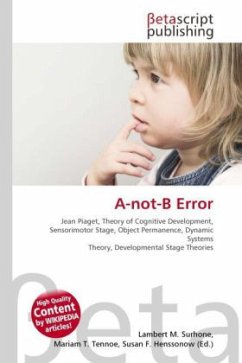
A-not-B Error
Versandkostenfrei!
Versandfertig in 6-10 Tagen
26,99 €
inkl. MwSt.

PAYBACK Punkte
13 °P sammeln!
High Quality Content by WIKIPEDIA articles! High Quality Content by WIKIPEDIA articles! A-not-B error (also known as "stage 4 error" or "perseverative error") is a phenomenon uncovered by the work of Jean Piaget in his theory of cognitive development of children. The A-not-B error is a particular error made by young children during substage 4 of their sensorimotor stage. A typical task goes like this: An experimenter hides an attractive toy under box "A" within the baby's reach. The baby searches for the toy, looks under box "A", and finds the toy. This activity is usually repeated several tim...
High Quality Content by WIKIPEDIA articles! High Quality Content by WIKIPEDIA articles! A-not-B error (also known as "stage 4 error" or "perseverative error") is a phenomenon uncovered by the work of Jean Piaget in his theory of cognitive development of children. The A-not-B error is a particular error made by young children during substage 4 of their sensorimotor stage. A typical task goes like this: An experimenter hides an attractive toy under box "A" within the baby's reach. The baby searches for the toy, looks under box "A", and finds the toy. This activity is usually repeated several times (always with the researcher hiding the toy under box "A"). Then, in the critical trial, the experimenter moves the toy under box "B", also within easy reach of the baby. Babies of 10-months or younger typically make the perseverance error, meaning they look under box "A" even though they saw the researcher move the toy under box "B", and box "B" is just as easy to reach. This demonstratesa lack of, or incomplete, schema of object permanence. Children of 12-months or older typically do not make this error.












